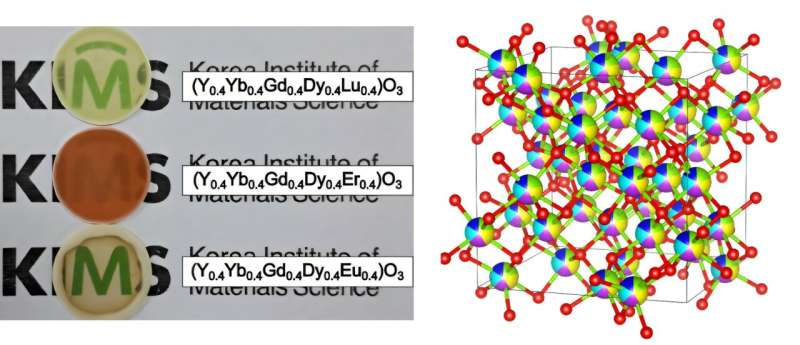A research team has successfully developed a new composition and processing technology for transparent plasma-resistant high-entropy ceramics. This innovation is the first of its kind in the world and is designed to extend the lifespan of internal components in semiconductor etching equipment while reducing contamination particles during the semiconductor manufacturing process. The study is published in the Journal of Advanced Ceramics.
Ceramics account for over 90% of the materials used in the internal components of semiconductor etching equipment. One of the main reasons is their superior plasma resistance compared to other materials. Similar to how a ship rusts when exposed to seawater, plasma used during the etching process continuously reacts with the internal components of the equipment, leading to corrosion and contamination.
To address these issues, ceramics are employed as the material of choice. However, as semiconductor integration levels increase, etching processes are conducted in increasingly harsh environments. This has resulted in more frequent replacements of conventional ceramic components, which negatively impacts semiconductor productivity.
The research team broke away from the limitations of traditional ceramic materials, such as yttria (Y₂O₃), alumina (Al₂O₃), and YAG (yttrium aluminum garnet), by designing a new high-entropy ceramic composition.
Using a sintering process for inorganic dense bodies (high-density solid-state materials), they successfully developed transparent ceramics with a density of 99.9%. These dense ceramics are suitable for use in etching process equipment that requires plasma resistance.
Furthermore, the team analyzed the changes in crystal structure of the elements comprising the high-entropy ceramic and developed transparent ceramics capable of transmitting visible and infrared light by controlling porosity.

High-entropy ceramics are a type of ceramic material created by mixing five or more elements to form a single phase (uniform structure) without generating impurities, unlike conventional materials. These ceramics exhibit unique properties such as high heat resistance, excellent wear resistance, and low thermal conductivity, which have made them increasingly prominent as thermal barrier materials, catalysts, and energy storage materials.
However, research on their plasma resistance had not been conducted until now. Recognizing this gap, the research team focused on this area and successfully achieved the world’s first development of plasma-resistant high-entropy ceramics.
In semiconductor processes, a material with a low etch rate indicates fewer contamination particles and higher durability. The high-entropy transparent ceramic developed by the research team exhibited an exceptionally low etch rate, achieving just 1.13% compared to sapphire. Furthermore, when compared to yttria (Y₂O₃), known for its excellent plasma resistance, it demonstrated an etch rate of only 8.25%, thereby confirming its superior durability.
Senior Researcher Ho Jin Ma from KIMS stated, “In semiconductor processes, plasma etching is dominated by materials, components, and equipment from the U.S. and Japan, which account for over 90% of the market, leaving the domestic industry heavily reliant on foreign sources.
“This research achievement is a prime example of developing a high-entropy ceramic, a material that has never been studied before, to create a world-class plasma-resistant material using domestic proprietary technology. It is expected to serve as a cornerstone for achieving material self-sufficiency and advancing the localization of components.”
The study was a collaboration by the Korea Institute of Materials Science (KIMS) and Professor Jeong-Woo Lee’s research team from Pusan National University.
More information:
Yu-Bin Shin et al, Novel transparent high-entropy sesquioxide ceramics with high physicochemical plasma etching resistance, Journal of Advanced Ceramics (2024). DOI: 10.26599/JAC.2024.9221013
Citation:
Novel transparent ceramics extend life of semiconductor etching equipment (2025, February 14)
retrieved 14 February 2025
from https://techxplore.com/news/2025-02-transparent-ceramics-life-semiconductor-etching.html
This document is subject to copyright. Apart from any fair dealing for the purpose of private study or research, no
part may be reproduced without the written permission. The content is provided for information purposes only.

